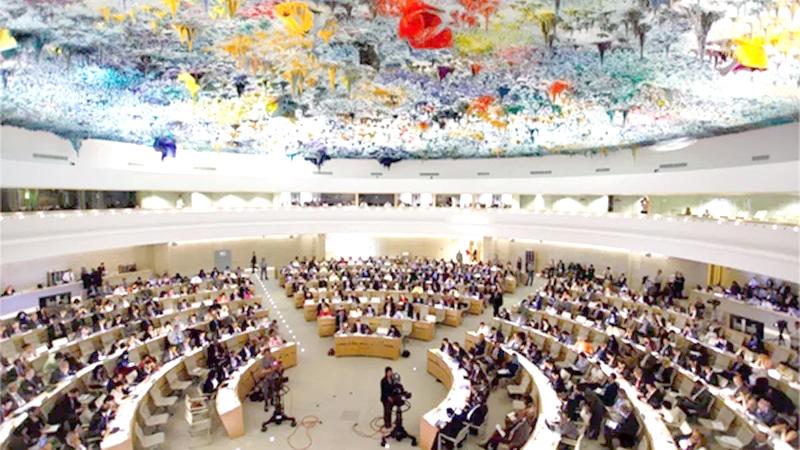
Sri Lanka will discuss its implementation of UNHRC Resolution 30/1 on March 20 in Geneva at the on going 40th session of the UNHRC. The 30/1 resolution was passed in 2015 and shared the Sri Lankan Government gaining control of the restorative procedures needed to facilitate reconciliation in a nation that had seen a long standing history of violence postindependence.
There has been some confusion regarding what the clauses of the resolution involve with hearsay and rumour claiming 30/1 poses a threat that furthers Western interests at the expense of Sri Lanka’s autonomy and self-governance. Nothing could be further from the truth.
This sort of isolationist rhetoric has always preceded Sri Lanka’s exchanges with the international community and even further has always preceded the country’s approach to elections. To make matters even more confusing political individuals that claim the agreement is a danger to national interests seem to be suffering from a form of convenient amnesia, ignoring that many of the recommendations of the 30/1 resolution had also been previously suggested by the former government as early as 2011.
Resolution 30/1 was co-sponsored by the Sri Lankan Government in 2015, signalling to the Sri Lankan public the state’s adoption of the reconciliation process and its handling domestically. The recommendations the Government of Sri Lanka (GoSL) took charge of have become the main feature of the state’s Transitional Justice Agenda.
The procedures highlighted a series of steps some of which were to investigate violations and abuses by the LTTE, amend the Criminal Procedure Code, look into the provision of training and education on human rights and transitional justice for the military, investigate past attacks on minorities, journalists, activists as well as places of worship.
Most noteworthy, however was the establishment of Truth and justice Mechanisms, namely the Office on Missing Persons (OMP), The Office for Reparations (OR) and the Commission for Truth and Reconciliation (TRC). It is through falsifying the functions of the above mechanisms that claims regarding the 30/1 resolution and its supposed endangerment of state sovereignty have risen.If certain individuals involved in Sri Lanka’s long list of violent events - the Anti-Muslim Pogroms, Civil War, 1983 riots, are to be tried. It will be done so domestically.
What seems to have occurred is that politically charged parties are twisting the truth on the function of what these mechanisms involve to stir the pot. It must be noted that while the 30/1 resolution involves a domestically handled judicial processes its efforts are more likely to involve reparations both in the financial sense as well as in other forms such as education, memorialisation and an increase in the representation of women.
In 2011, under the authority of Former President Mahinda Rajapaksa the Lessons Learnt and Reconciliation Commission (LLRC) presented a comprehensive report on Government’s collection of the sequence of events that had transpired between the period 2002-2009.
The LLRC made many recommendations for what it thought was the best way to prevent recurrence of the violence Sri Lanka had faced during the period. The recommendations under pages 248 and 249 of the LLRC refer to the Rehabilitation of Persons, Properties and Industry Authority (REPPIA) and suggest it functions in dispensing post-conflict reparations.
It might come as a surprise then to critics of 30/1 that the OR established after the 2015 resolution largely absorbed the functions of REPPIA for the purpose of post conflict reparation, in effect putting into practice a recommendation that had been suggested as far back as 2011.
A 2015 interim report by Former High Court Judge Maxwell Paranagama, commissioned under Former President Rajapaksa suggests that bureaus be established across districts to report missing persons (First Mandate, Chapter XIV, 10).
Following 30/1 this function was transferred to the OMP which is currently in the process of setting up regional offices in key districts with Matara already set up and Mannar soon to follow.
It only begs the question, if these recommendations had been made before the passing of resolution 30/1 as far back as 2011 why is there such opposition to it now?
The ‘Western Conspiracy’ narrative in Sri Lankan politics has always preceded elections. With polls just around the corner it appears that political individuals have found the falsification of the 30/1 resolution a thrilling plot device in their hopes to mislead the public and snatch up votes.
Nationalistic fronts would rather distort the true value of reconciliation and its potential for the Sri Lankan people even if the leader of the former Government fully endorsed its suggestions.
By misleading voters on the actual procedures of 30/1 politically charged bodies are robbing the Sri Lankan public of resolution, healing and progressive reforms of which it is in dire need. It is regrettable that the falsification of the 30/1 resolution might be used to buy cheap votes, a far cry from its intended purpose of bringing reconciliation to victims. However, the narrative of a Western conspiracy itself has become hackneyed and it is almost completely possible that the Sri Lankan public might stir, put down this book and usher in a new chapter of restoration.
